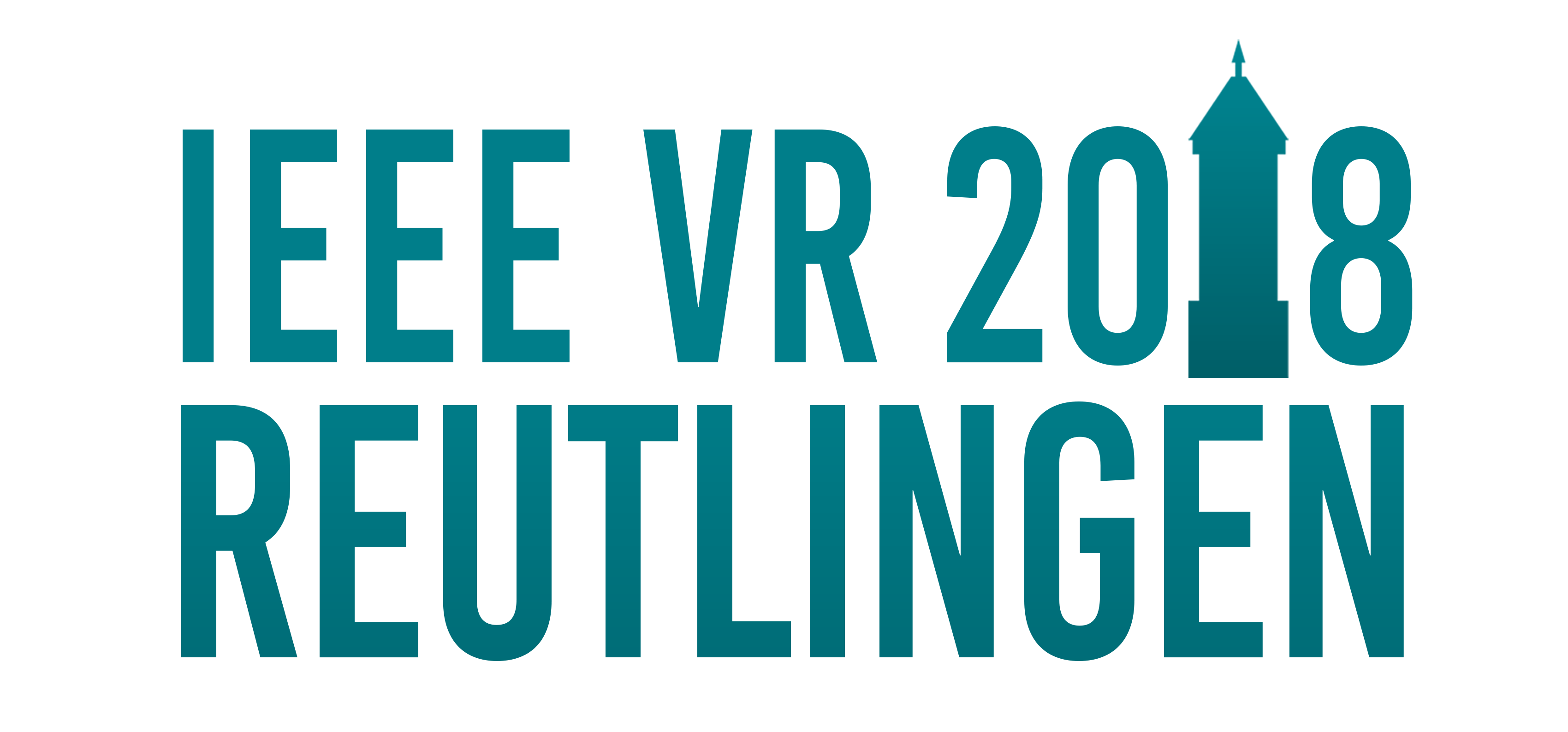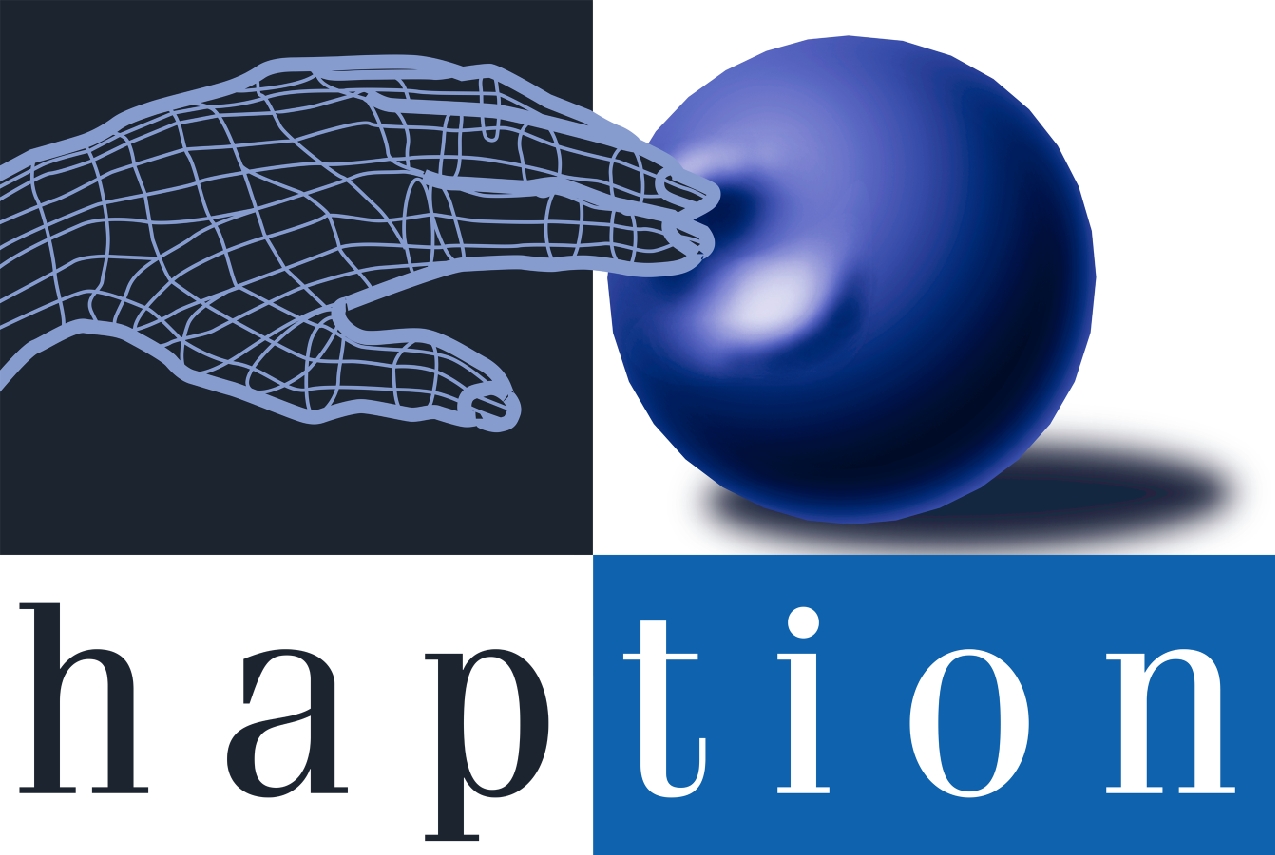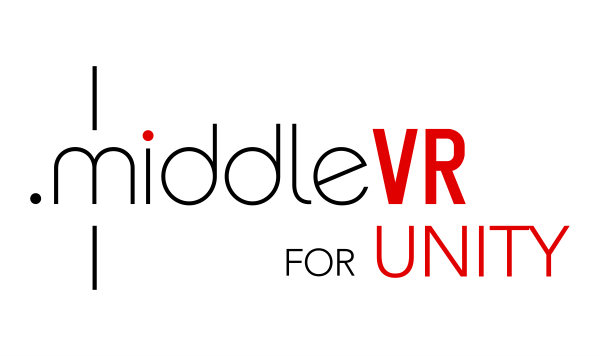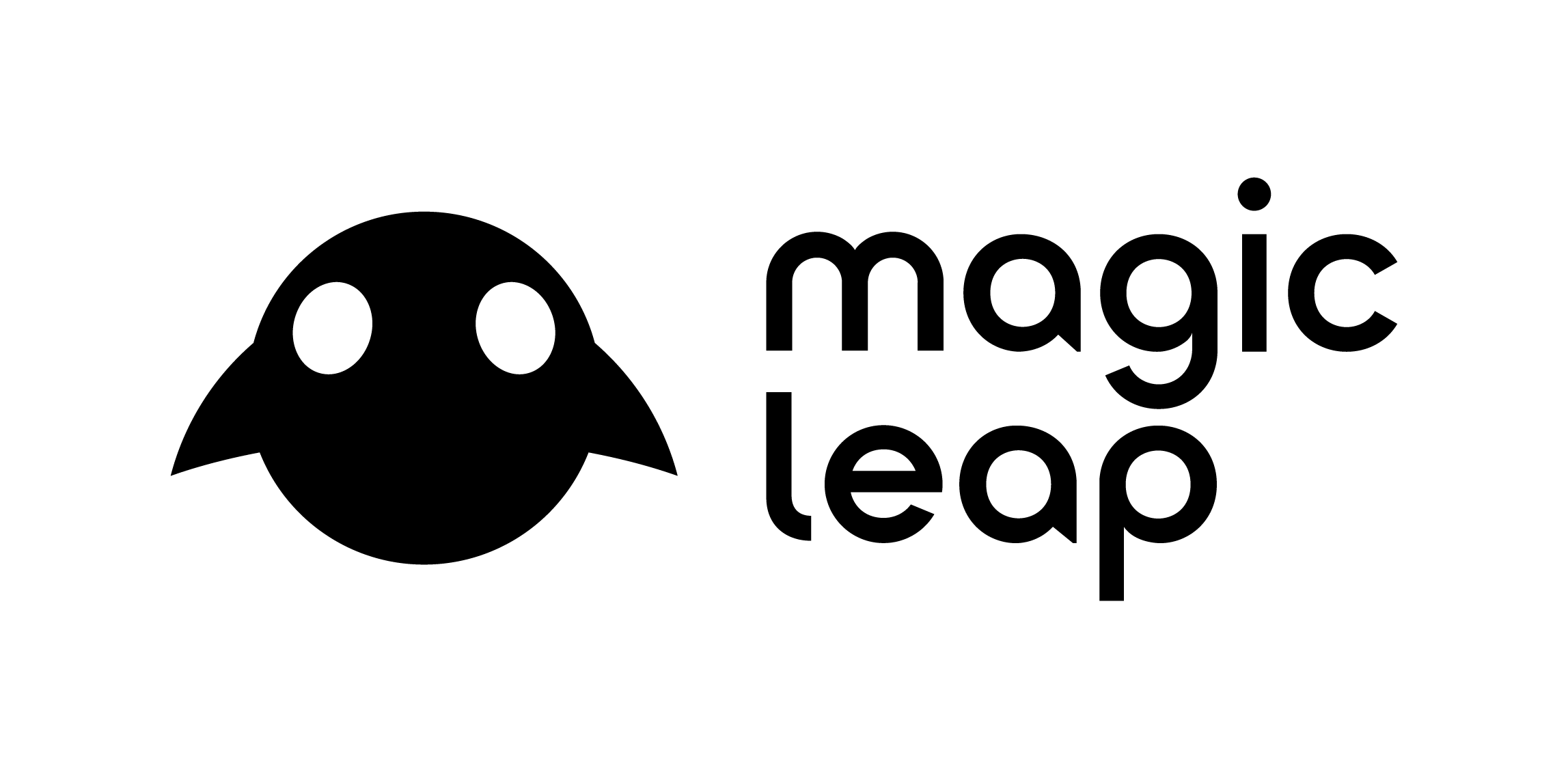
March 18th - 22nd

March 18th - 22nd
In Cooperation with
the German Association for Electrical, Electronic and Information Technologies: VDE


![]()
In Cooperation with
the German Association for Electrical, Electronic and Information Technologies: VDE


Exhibitors and Supporters
Diamond

National Science Foundation
Gold
VICON

Digital Projection
Gold Awards

NVIDIA
Silver

ART
Bronze

Haption

MiddleVR

VR-ON

VISCON

BARCO

Ultrahaptics

WorldViz

Disney Research

Microsoft
Non-Profit

Computer Network Information Center
Sponsor for Research Demo

KUKA
Other Sponsors

Magic Leap
Exhibitors and Supporters
Panels
The following panels will be held at IEEE Virtual Reality 2018, from March 20th to 22nd.
- Virtual reality for interdisciplinary applications
- How should social mixed reality work?
- Getting close to domain users: VR and AR in support of application domains
- The future impact of neuroscience and cognitive psychology on virtual environments
Panel 1: Virtual Reality for Interdisciplinary Applications
Tue, March 20th, 2:00 PM (75 min)
Overview
Opportunities for virtual reality research and applications have grown tremendously with the new technologies that have become available at the consumer level. Many disciplines now have the chance to implement virtual reality to address domain-specific problems, but barriers still remain as the potential of virtual reality to non-specialists may not be apparent. This panel gives methods on how to use virtual reality productively in interdisciplinary applications. The panelists will present and discuss their experiences on methods for forging interdisciplinary applications in research and education that lead to innovation in both the area of virtual reality and in other disciplines. Interdisciplinary collaborations draw on the different expertise and strengths of multiple investigators that provide an informed and principled way of addressing innovative problems. Interdisciplinary applications involving virtual reality have high potential for supporting research that translates to solving real-world problems addressing clinical populations—such as anxiety disorders and autism—as well as those that address technology-driven societal challenges such as spatial navigation, social interaction, decision making, and communication with media. This panel will feature researchers who have extensive experience in many of these areas of interdisciplinary application. The panel will begin with speakers providing a short (5 minutes or less) statement on their approach to interdisciplinary application, and an introduction of both the challenges faced and opportunities afforded. The goal will be to take a forward-looking position and to engage the audience in an active dialog about new directions and possibilities for VR applications that are informed by bringing together researchers and educators from the sciences, humanities, and engineering. The panel will focus on such questions as: how do you find and foster (“jumpstart”) interdisciplinary collaborations? How do you navigate the issues associated with every discipline having a different jargon? Can you come up with effective plans for achieving publications in each discipline? When do you say “no”, that is, how do you avoid becoming an academic VR studio-for-hire?
Moderator: Sarah Creem-Regehr, Ph.D.
University of Utah
Dr. Creem-Regehr is a Professor of Psychology at the University of Utah. Her research interests are in space perception and spatial cognition in real and virtual environments, with an emphasis on underlying mechanisms relating to action and body- based perception. Her work studies how perceptual theory and applications relating to virtual environments have mutually informed an understanding of large-scale space perception. Her research has included the influence of selfavatars on perception and action, visual-motor recalibration, spatial perspective taking, and navigation.
Panelists:
- Bobby Bodenheimer, Ph.D.
Vanderbilt University
Dr. Bodenheimer is an Associate Professor of Computer Science at Vanderbilt University. His current research is in the area of virtual reality, specifically how people learn and interact in virtual spaces. This work involves approaching fundamental questions about perception and action in the context of immersive virtual environments and the technologies that build them. Pursuing these questions leads to technological innovation in the design of virtual systems. His recent work using commodity level head-mounted displays involves questions of self-avatars, affordances, and distance perception. - Jeanine Stefanucci, Ph.D.
University of Utah
Dr. Stefanucci is an Associate Professor in the Psychology Department at the University of Utah. Her research focuses on better understanding if a person’s bodily states, whether emotional, physiological, or physical, affects their spatial perception and cognition. She conducts this research in natural settings (outdoor or indoor), and in virtual environments. This work is inherently interdisciplinary given it spans research on emotion, health, spatial perception and spatial cognition. She has also co-authored the book Visual Perception from a Computer Graphics Perspective with psychology and computer science colleagues. - Bernhard Riecke, Ph.D.
Simon Frasier University
Dr. Riecke is a psycho-physicist and Cognitive Scientist who’s excited about studying how humans orient in virtual and real environments. His research approach combines fundamental scientific research with an applied perspective of improving human-computer interaction. In particular, he combines multi-disciplinary research approaches and immersive virtual environments to investigate what constitutes effective, robust, embodied and intuitive human spatial cognition, orientation and behavior. This fundamental knowledge is used to guide the design of novel, more effective human-computer interfaces and interaction paradigms that enable similar processes in computer-mediated environments like virtual reality (VR) and multi-media. These improved interfaces can then enable and inspire further research, both fundamental and applied. - Antonia Hamilton, Ph.D.
University College London
Dr. Hamilton is a Senior Lecturer and leader of the Social Neuroscience group at the Institute of Cognitive Neuroscience (UCL). Prior to that, she completed a PhD on the impact of neuronal noise for the optimal control of human arm movements (UCL), and postdoctoral work on imitation in autism and brain systems for action understanding. She was a lecturer at the University of Nottingham until 2013, and was awarded the Experimental Psychology Society prize lectureship for 2013. Her current research interests include how and why people imitate each other, how social skills differ in autism, and the neural mechanisms of social interaction. - Peter Willemsen, Ph.D.
University of Minnesota Duluth
Dr. Willemsen runs the Simulation and Interaction in Virtual Environments (SIVE) Lab at the University of Minnesota, Duluth. The SIVE Lab specializes in interactive simulations that use GPU-based resources, or benefit from interactive, immersive visualization capabilities. His research efforts are highly interdisciplinary and are focused on the simulation of physical phenomena and interaction within virtual environments. The GEnUSiS group simulates the complex interactions between urban cities and the environmental aspects of pollution dispersion and energy use, while developing immersive and interactive decision support systems for communicating simulation results. In another project, his group is developing a stereo-projection virtual environment at UMD that integrates with the University of Utah’s TPAWT (TreadPort Active Wind Tunnel) to explore locomotion and haptic terrain rendering with a robotic shoe device. - Alexander Klippel, Ph.D.
Pennsylvania State University
Dr. Klippel is Professor of Geography and the Gosnell Senior Faculty Scholar at Pennsylvania State University. His research interests include spatial cognition, wayfinding, geographic event conceptualization, formal characterizations of dynamic spatial processes, location-based services, landscape and land cover concepts, crowdscience and crowdsourcing, and virtual reality and 3D modeling. Before coming to Penn State, Klippel worked as a Postdoctoral Research Associate at the CRC for Spatial Information, Geomatics Department, and was a founder member of the Spatial Information Science Research Group, The University of Melbourne. He also spent time at the Geography Department and Cognitive Science Emphasis at the University of California, Santa Barbara. Klippel received his Ph.D. in Informatics and Mathematics from the University of Bremen.
Panel 2: How should social virtual reality work?
Wed, March 21st, 11:00 AM (90 min)
Overview
There are now several social applications for immersive virtual reality systems. Recent studies show that users are starting to engage with these systems for more extended periods, and that they are reaching audiences that wouldn’t normally socialise in online games. The applications provide a variety of different ways of engaging with spaces, different tasks to engage with and different representations of humans. This panel will raise and discuss issues around the future of such systems. How should social mixed reality should be constructed in order to support the types of experience that we want to have. We will bring together platform holders and developers with researchers. We will take an inter-disciplinary look at the issues. This will span:
- How broad should tools for avatar customisation be?
- What procedures, tools or governance should support fair and equitable use of these spaces?
- How do we support accessibility across the general population?
- What should an open platform support or ban in terms of varying identity, appearance, filtering of tracking (e.g. not revealing eye-tracking)?
- What potentialities for social interaction are not supported by current platforms?
- How will social mixed reality applications work?
Moderator: Prof. Anthony Steed
https://wp.cs.ucl.ac.uk/anthonysteed/
University College London
Prof. Anthony Steed is Head of the Virtual Environments and Computer Graphics (VECG) group at University College London. Prof. Steed’s research interests extend from virtual reality systems, through to mobile mixed-reality systems, and from system development through to measures of user response to virtual content. He has worked extensively on systems for collaborative mixed reality. He is lead author of the book “Networked Graphics: Building Networked Graphics and Networked Games”. He was the recipient of the IEEE VGTC’s 2016 Virtual Reality Technical Achievement Award.
Panelists:
- Dr. Raz Schwartz, Facebook
Dr. Raz Schwartz is a research lead on the Oculus User Research team at Facebook. Prior to Facebook, Raz was a postdoctoral researcher at Cornell Tech and at Rutgers University as well as a research fellow at the Brown Institute for Media Innovation at Columbia Journalism School. His research examines social interactions in an immersive virtual reality environment by applying qualitative and quantitative methods. Raz’s work was published in various prestigious academic settings and was featured in media outlets such as the Wall Street Journal, Wired, Rhizome, and The Atlantic. - Nicole Krämer, University Duisburg-Essen
https://www.uni-due.de/sozialpsychologie/kraemer.shtml
Prof. Nicole Krämer is Professor for “Social Psychology – Media and Communication” at the University Duisburg-Essen, Germany. She finished her PhD in 2001 at the University of Cologne with a thesis on socio-emotional effects of nonverbal behaviour and computer animation as a method in communication research. In 2006, she received the venia legendi for psychology with the habilitation thesis on “Social effects of embodied conversational agents.” Her research interests include human-computer-interaction, social psychological aspects of social media, nonverbal behaviour and computer supported instructional communication. - Prof. Andrea Stevenson Won, Cornell
https://communication.cals.cornell.edu/people/andrea-won
Prof. Andrea Stevenson Won directs the Virtual Embodiment Lab. The lab’s research focuses on how mediated experiences change people’s perceptions, especially in immersive media. Research areas include the clinical applications of virtual reality, and how nonverbal behavior as rendered in virtual environments affects collaboration and teamwork. Andrea Stevenson Won completed her PhD in the Virtual Human Interaction Lab in the Department of Communication at Stanford University. She also holds an MS in Biomedical Visualization from the University of Illinois at Chicago. - Laura Trutoiu, MagicLeap
http://www.cs.cmu.edu/~ltrutoiu/
Dr. Laura Trutoiu is a Senior Computer Scientist in Magic Leap’s Advanced Technology office in Seattle. Her research spans computer graphics, human perception, and sensing and interaction for virtual and augmented reality systems. Laura’s prior work has focused on enabling face-to-face communication in head-mounted displays and realistic facial animations for avatars. She has conducted research in various industrial settings including Disney Research, Industrial Light and Magic, and more recently Oculus Research.
Panel 3: Getting close to domain users: VR and AR in support of application domains
Wed, March 21st, 2:00 PM (75 min)
Overview
The last couple of years have been marked by an explosion of solutions in the VR and AR domains: the accepted norm of this market has been to provide users with lightweight VR and AR displays, input controllers that recognize human gestures, superior tracking solutions, as well as software development environments that enable much faster prototyping and development of high quality applications. Those contemporary commercial off the shelf VR/AR hardware and software solutions are not only affordable to research laboratories, their price also makes them accessible to large number of potential users – having uninterrupted access to inexpensive tools is an important element of the diffusion process and adoption of any innovation.
While VR community witnesses a renewed vigor and a wealth of studies in the domain of basic research, the absence of equally vibrant research in different application domains that most directly benefit users is also evident. This lack of extensive research focused on testing suitability and effectiveness of different VR/AR solutions in application domains inevitably results with a lack of tried and proven standards on how and when to use VR/AR solutions effectively and efficiently in those domains. The existence of those standards is one of several major elements that masses of users need if they are to change their daily practices and incorporate VR/AR solutions in their work environments. The promise of large scale adoption of VR/AR solutions therefore still remains the promise in many application domains.
We believe this point in time is perfect to start bringing our understandings from basic research and start actively applying them to a diverse set of application domains. The goal of this panel is to raise awareness and bring to the attention of the VR/AR research community the various needs and opportunities for research in different application domains. Below are some of the topics and questions highlighting the issues the researches who work in different application domains need to address:
- What may be the reasons for low number of publications that report studies done in specific application domains?
- What type of knowledge, skills and any other investment one needs to make to conduct investigations in given application domain(s)?
- Ups and downs of user studies that involve domain users. Tips and best practices for involving them.
- Experiences with metrics and measurement of the specific application domains.
- Standards of use in application domains (when and how to use VR/AR solutions).
- Taking into consideration things beyond VR/AR hardware and software ((examples: pedagogy, training approaches).
- The role of COTS (commercial off the shelf) solutions in work with domain users?
- Strategies to deploy VR/AR equipment “in the field”.
- Do we have to think about large scale adoption issues when doing research and why?
- Perceived obstacles for large scale adoption of VR/AR solutions in different application domains.
- Future work/frontiers, much-needed work, novel research avenues that address needs of domain users.
- Building lucrative relationships among industry, government and academic representatives. Opportunities for collaboration.
This panel brings researchers whose research agenda is firmly based in a variety of application domains: medicine, rehabilitation, sports, education, firefighting and military. The panel will start with each panelist commenting their major research focus and approach while working in different application domains (5 min each). The moderator will then initiate the discussion on different questions with participation from the audience.
Moderator: Benjamin Lok, Ph.D.
http://www.lokben.com
University of Florida
Dr. Lok is a Professor in the Computer and Information Sciences and Engineering Department at the University of Florida and co-founder of Shadow Health, Inc., an educational software company. His research focuses on virtual humans and mixed reality in the areas of computer graphics, virtual environments, and human-computer interaction. His work with virtual patients is now used in over 1500 nursing programs across the world with hundreds of thousands of nursing students using virtual patients to improve communication skills.
Panelists:
- Albert “Skip” Rizzo, Ph.D.
http://ict.usc.edu/profile/albert-skip-rizzo University of Southern California
Dr. Rizzo is the Director of MedVR at the USC Institute for Creative Technologies. Over the last 20 years, Skip has conducted research on the design, development and evaluation of VR systems across the domains of psychological, cognitive and motor functioning in healthy and clinical populations. In spite of the diversity of these clinical R&D areas, the common thread that drives all of his work with digital technologies involves the study of how Virtual Reality simulations can be usefully applied to human healthcare beyond what’s possible with traditional 20th Century methods. - Amela Sadagic, Ph.D.
http://www.movesinstitute.org/~amela
Dr. Sadagic is a Research Associate Professor at the Naval Postgraduate School (NPS) with 30 years long research experience in interactive computer graphics and Virtual Reality. In the past she coordinated the National Tele-immersion Initiative (NTII) research consortium, and was a Director of Programs responsible for designing and directing projects for K-12 education that employed emerging technologies. Her research interests include human factors in VR/AR; coupling and evaluation of emerging technologies in support of systems for operation, training, and learning; additive manufacturing and diffusion and large-scale adoption of technical innovations. Her research efforts at NPS have been supported by $10M in funding, and involved over 4500 US Marine Corps and US Navy personnel as subjects in user studies. - Dr. Hannes Kaufmann
https://www.ims.tuwien.ac.at/~kaufmann
Technische Universität Wien
Dr. Kaufmann is associate professor at Vienna University of Technology and head of the VR group since 2005. He conducted research in multiple VR and AR application domains, including education, training (different areas), rehabilitation, and worked in projects in the areas of tracking, mobile AR navigation, training spatial abilities in AR/VR, tangible interaction, real time ray-tracing in AR, redirected walking and more. His Habilitation “Applications of Mixed Reality” had a major focus on educational mixed reality applications. He managed over 20 national research projects and published more than 90 scientific papers to date. - Prof. Dr. James P. Bliss
https://www.odu.edu/directory/people/j/jbliss
Old Dominion University
Dr. Bliss joined the Psychology Department at Old Dominion University as an Associate Professor in 2001. He earned tenure in 2004, was promoted to Full Professor in 2012, and was department chair from 2013 to 2016. He and his students conduct research in two primary areas. He is interested in what factors contribute to the development of automation mistrust, and how designers and trainers can optimize compliance. The second broad area includes the use of virtual environments for task training. Dr. Bliss has received funding from DARPA, AFRL, OSD, the US Army, US Navy, NASA, and AFOSR. - Kyle Johnsen, Ph.D.
http://www.engineering.uga.edu/people/profile/kyle-johnsen-ph.d
University of Georgia
Dr. Johnsen is an Associate Professor in the School of Electrical and Computer Engineering at the University of Georgia and is the founding director of the Georgia Informatics Institutes (GII) for Research and Education. His highly interdisciplinary research is in the design and evaluation of novel human-computer systems, particularly those that involve ubiquitous computing and virtual reality, that address societal problems. Examples of his work can be found in the NOAA-funded Marine Debris Tracker App (marinedebris.engr.uga.edu), NSF-funded Virtual STEM Buddies exhibit at the Children’s Museum of Atlanta, and NIH-funded nervesim.com.
Panel 4: The future impact of neuroscience and cognitive psychology on virtual environments
Thu, March 22nd, 11:00 (90 min)
Overview
Virtual environments (VEs: Virtual Reality, Augmented Reality, Mixed Reality, and Augmented Virtuality) have benefitted from the fields Neuroscience and Cognitive Psychology. Many VE techniques are based on known findings such as change blindness and the rubber hand illusion. Neuroscience, Cognitive, and Clinical Psychology have also benefits for VE technologies, such as treatments for phobias and pain modification. This panel will explore new VE research directions and potential impacts associated with Neuroscience and Cognitive Psychology.
The rapid advancement of sensing technologies (such as electroencephalography (EEG), near field infrared brain scan (fNIRS), positron emission tomography (PET) and Magnetic resonance imaging (MRI)) have created new opportunities to better understand brain/behaviour relationships using VEs. We are now able to gain a better understanding of the impact of VEs on learning, training, supporting industrial tasks, and long-term usage. VE technology is now entering a phase of being a consumer/commodity product. The panel with explore how the wide spread usage of VEs effect their usage for treatments in the Neuroscience and Cognitive Psychology domain. The current authoring tools are lowering the barrier of entry into the development of virtual worlds.
The panel with explore the following questions:
- How do VEs effect the human brain and behavior?
- What are some related potentially high impact applications of VEs?
- How will this lower barrier of entry impact Neuroscience and Cognitive Psychology research?
- What new directions in these areas can be supported in the future?
Moderator: Prof. Bruce H. Thomas
University of South Australia
Bruce H. Thomas is a Professor of Computer Science at the University of South Australia. Professor Thomas is the current the Deputy Director of the Advanced Computing Research Centre, Director of the Mawson Institute SAR Visualisation Lab, and Director of the Wearable Computer Laboratory at the University of South Australia. He is currently a Senior Member of the ACM, Senior Member of the IEEE, Visiting Professor (Global) Keio University, and visiting Scholar with the Human Interaction Technology Laboratory, University of Washington. His current research interests include: wearable computers, user interfaces, augmented reality, virtual reality, visualisation, CSCW, and tabletop display interfaces.
Panelists:
- Frank Steinicke, Ph.D
University of Hamburg
Frank Steinicke is a professor for Human-Computer Interaction at the Department of Informatics at the University of Hamburg. His research is driven by understanding the human perceptual, cognitive and motor abilities and limitations in order to reform the interaction as well as the experience in computer-mediated realities. Frank Steinicke regularly serves as panelist and speaker at major events in the area of virtual reality and human-computer interaction and is on the IPC of various national and international conferences. He serves as the program chair for IEEE VR 2017/2018, which is the most renowned scientific conference in the area of VR/AR. Furthermore, he is a member of the Steering committee of the ACM SUI Symposium and the GI SIG VR/AR, and currently editor of the IEEE Computer Graphics & Applications Department on Spatial Interfaces. - Albert “Skip” Rizzo, Ph.D.
http://ict.usc.edu/profile/albert-skip-rizzo
University of Southern California
Skip Rizzo is a clinical psychologist and Director of Medical Virtual Reality at the USC Institute for Creative Technologies. He is also a Research Professor with the USC Dept. of Psychiatry and at the USC Davis School of Gerontology. Over the last 20 years, Rizzo has conducted research on the design, development and evaluation of Virtual Reality systems targeting the areas of clinical assessment, treatment and rehabilitation across the domains of psychological, cognitive and motor functioning in both healthy and clinical populations. This work has focused on PTSD, TBI, Autism, ADHD, Alzheimer’s disease, stroke and other clinical conditions. In spite of the diversity of these clinical R&D areas, the common thread that drives all of his work with digital technologies involves the study of how interactive and immersive Virtual Reality simulations can be usefully applied to address human healthcare needs beyond what is possible with traditional 20th Century tools and methods. - María V. Sanchez-Vives, M.D., PhD
Institut d’Investigacions Biomèdiques August Pi i Sunyer
María V. Sanchez-Vives, MD, PhD in Neurosciences, has been ICREA Research Professor at the IDIBAPS (Institut d’Investigacions Biomèdiques August Pi i Sunyer) since 2008, where she is Head of the Systems Neuroscience group. She is also co-Director of the Event Lab (Experimental Virtual Environments in Neuroscience and Technology) and Adjunct Professor at the Dept. of Basic Physiology, University of Barcelona. She previously held a position as Associate Professor of Physiology and Group Leader at the Instituto de Neurociencias de Alicante (UMH-CSIC). She was Postdoctoral Fellow at Rockefeller University and Postdoctoral and Research Associate scientist at Yale University. Her independent research has been supported by national and international agencies. Since 2013 she is Chief Editor of Frontiers in Systems Neuroscience. - Petr Legkov
University of Osnabrück
Petr Legkov is a researcher at the University of Osnabrück, and he is a VR Engineer / Networker at SALT AND PEPPER Software GmbH & Co. KG, engineering virtual reality solutions for industrial needs and managing the network of our virtual reality connections. Petr will provide an academic view from an early career researcher. His work in EEGs and VR are quite novel.